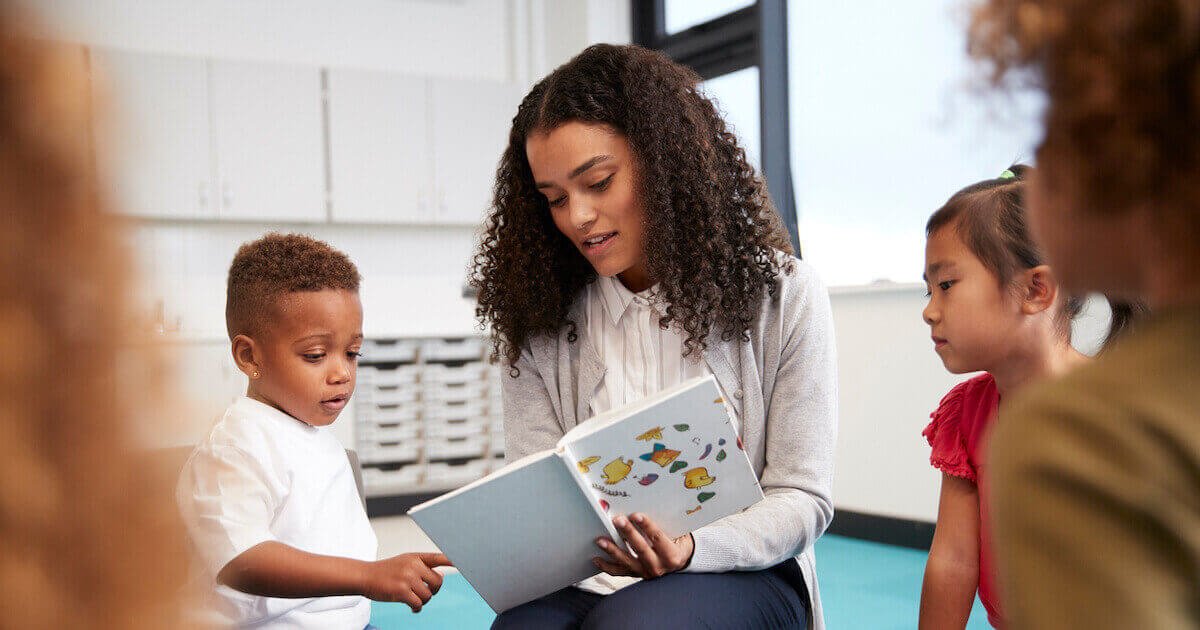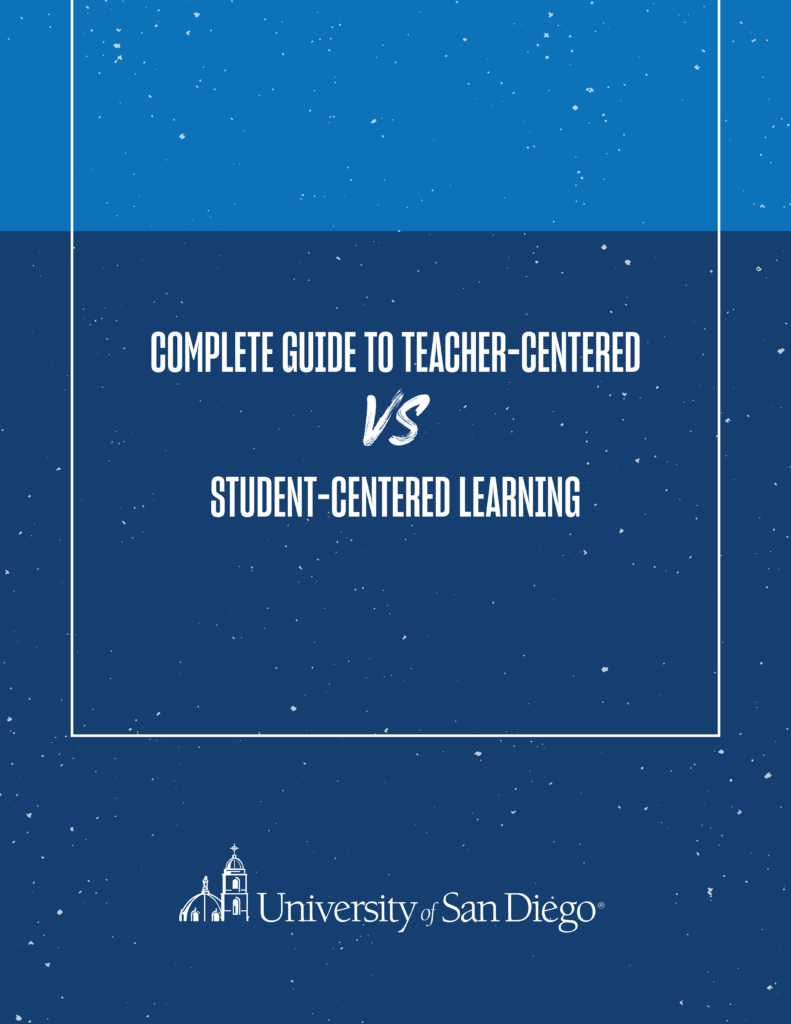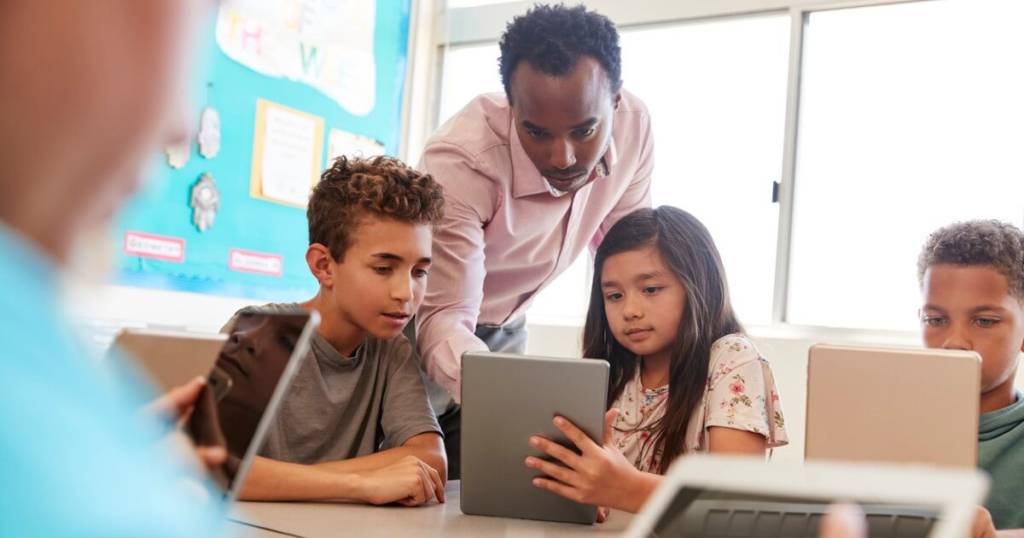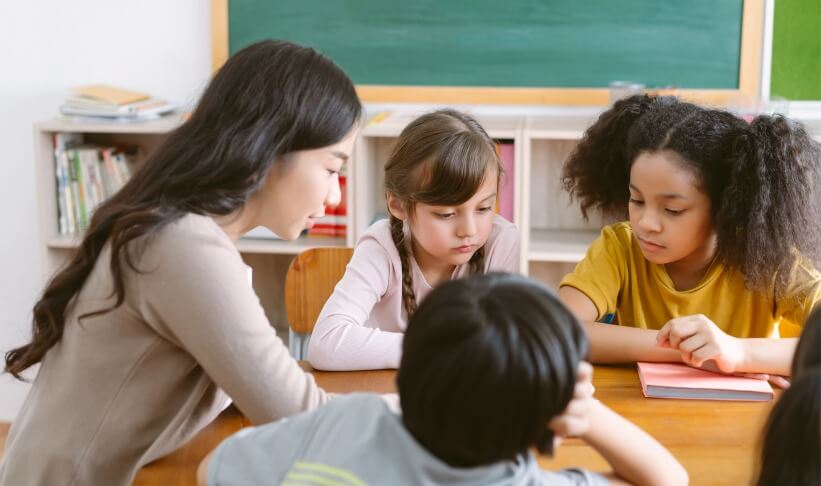Who’s in charge here? When it comes to utilizing a student-centered vs. teacher-centered educational approach, the answer is the same: the teacher. However, a student-centered vs. teacher-centered classroom may look and feel very different to the outside observer.
Educators know the difference and many are adept at integrating aspects of both approaches into their teaching. However, as with anything, it is often helpful to have a quick refresher.
What is Teacher-Centered Learning?
What is Student-Centered Learning?
Teacher-Centered vs. Student-Centered Learning [Pros & Cons]
‘Sage on the Stage’ vs. ‘Guide on the Side’
‘I Stood in Front of the Classroom and Told People Things’
Student-Centered Learning in the Online (MEd) Classroom
Teacher-Centered vs. Student-Centered Learning FAQs
What is Teacher-Centered Learning?
In teacher-centered learning — the more traditional or conventional approach to teaching — the teacher functions in the familiar role of classroom lecturer, presenting information to the students, who are expected to passively receive the knowledge being presented.
A teacher-centered learning environment is one in which:
- The focus is primarily on the instructor
- The teacher chooses the topics
- The teacher talks and the students listen
- What the teacher knows about the subject takes priority
- Students work alone/independently
- The teacher monitors and corrects student work as needed
- The teacher is solely responsible for answering students’ questions
- The teacher evaluates students’ performance and evidence of learning
- The classroom is typically quiet
Sounds fairly traditional, right? This should paint a picture of a classic schoolroom in which the teacher presides over his or her pupils. But there’s a different — and potentially more successful — alternative.
What is Student-Centered Learning?
In student-centered learning, the teacher is still the classroom authority figure. However, they function as more of a coach or facilitator while students embrace a more active and collaborative role in their own learning.
A student-centered learning environment might look like one in which:
- The focus is shared by both the students and their teacher
- Students may have some choice in the topics they cover
- The instructor models a concept or challenge, then invites the students to explain or demonstrate it back to the class
- The students interact with their teacher and one another during the lesson
- Topics are delivered in familiar, everyday language students might use themselves; new vocabulary might get its own lesson
- Students work in pairs, in groups or alone depending on the activity
- The instructor refrains from constant monitoring but provides feedback or corrections when questions arise
- Students attempt to answer each other’s questions, using their teacher as an information resource or facilitator
- Students evaluate their own learning alongside the teacher/instructor
- The classroom is busy and filled with energy
A student-centered classroom may possess some or all of these qualities and may not work for every learning scenario. Some teachers and students may find student-centered learning too chaotic, but testing out a healthy mix of teacher-centered and student-centered methods may be the key to success.
YOUR MASTER’S DEGREE: Take an Inside Look at USD’s Online MEd [VIDEO] >>
Teacher-Centered vs Student-Centered Learning [Pros & Cons]
Benefits of a Teacher-Centered Classroom
- Order in the class! The teacher exercises full control of the classroom and activities.
- Being fully in control minimizes an instructor’s concern that students may be missing key material.
- When a teacher takes full responsibility for educating a group of students, the class benefits from a focused approach to research, planning and preparation.
- Teachers feel comfortable, confident and in charge of the classroom activities.
- Students always know where to focus their attention — on the teacher.
Drawbacks of a Teacher-Centered Classroom
- This method works best when the instructor can make the lesson interesting; absent this, students may get bored, their minds may wander and they may miss key information.
- Students work alone, missing potential opportunities to share the process of discovery with their peers.
- Collaboration, an essential and valuable skill in school and in life, is discouraged.
- Students may have less opportunity to develop their communication and critical thinking skills.
Benefits of a Student-Centered Classroom
- Education becomes a more shared experience between the instructor and the students, and between the students themselves.
- Students build both collaboration and communication skills.
- Students tend to be more interested in learning when they can interact with one another and participate actively in their own education.
- Students learn to both work independently and to interact with others as part of the learning process.
Drawbacks of a Student-Centered Classroom
- With students free to interact, the classroom space can feel noisy or chaotic.
- Classroom management can become more of an issue for the teacher, possibly cutting into instructional activities.
- With less focus on lectures, there can be a concern that some students may miss important information.
- Though collaboration is considered beneficial, this approach may not feel ideal for students who prefer to work alone.
- Some students may have difficulty focusing or retaining information in a collaborative, interactive setting.
[RELATED] An Educator’s Guide to Teaching Styles & Learning Styles >>
‘Sage on the Stage’ vs ‘Guide on the Side’
Sometimes called the “Sage on the Stage” style, the teacher-centered model positions the teacher as the expert in charge of imparting knowledge to his or her students via lectures or direct instruction. In this setting, students are sometimes described as “empty vessels,” listening to and absorbing information.
Though the teacher-centered learning method is historically considered the more traditional approach, the education field has evolved to recognize the significant benefits of empowering students to be more active participants in their own learning. However, there continue to be countless examples of students being challenged and transformed by a teacher lecturing about a subject they have spent their entire life exploring.
Sometimes called the “Guide on the Side” style, the student-centered learning model builds in more equanimity between the teacher and student, with each playing a role in the learning process. The teacher still exercises authority, but is more likely to act as a facilitator, coaching students and assisting them in their learning.
This approach, which has grown in popularity over the past several decades, champions student choice and facilitates connections among students, embracing the philosophy that, for a student to truly learn, they must be actively involved in the process.
‘I Stood in Front of the Classroom and Told People Things’
Writing about her transition from teacher-centered to student-centered instruction for an article in Medium.com, educator Martha Kennedy recalls, “I began teaching as most young teachers do, unconsciously modeling my teaching style on that of the teachers I’d had. I stood in front of the classroom and told people things.”
But in the mid-80s, she said, a “new idea” called student-centered education began to gain traction. As a writing teacher, she was aware of “the essential difference between teaching a skill and teaching content,” believing that while “you can tell people content; people must practice skills.”
To learn a skill, like writing for example, “students must be directly involved,” she says. “No teacher can stand there and tell the students how to do something and expect the students to leave the classroom able to do it.” However, because the teacher must willingly relinquish some control of the process and count on students to produce, Kennedy says, “Student-centered teaching feels risky.”
She recalls occasionally having to convince supervisors that her methods were sound, with one dean describing what appeared to be “total chaos” after sitting in on a four-hour class where students were haggling over ideas, some listening to music, taking breaks at times of their choosing and basically owning their approach to the assignment. She was able to convince the dean that listening to music helped some kids focus and that letting them take a breather when needed was preferable to potentially disrupting their train of thought with a scheduled group break.
“Over the years I came to understand that the main virtue of the student-centered classroom is that it removes mastery from the sole province of the teacher and allows students to be masters, too,” she said. “It means I needed to — sometimes — leave them alone so they could learn. I understood that teachers can actually impede students’ learning.”
[RELATED] 4 Proven Inclusive Education Strategies for Educators [Plus 6 Helpful Resources] >>
Student-Centered Learning in the Online (MEd) Classroom
Many teachers strive to implement a blend of teacher-centered and student-centered learning styles — sometimes within the same classroom — based on their own instincts, research and experience.
The student-centered approach to education also has relevance for teachers who choose to develop a deeper understanding of the art and science of education by pursuing a master’s degree.
For example, in contrast to the more teacher-centered approach that is common to on-campus programs, online master’s degree programs tend to place more emphasis on interacting with one’s fellow degree candidates across the country through the learning portals that are an essential component of the online academic experience.





